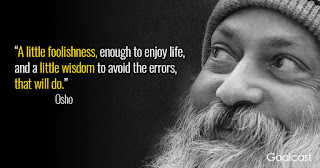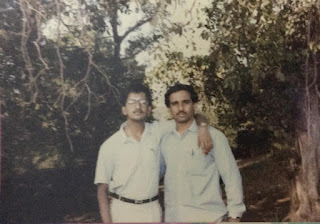Jottings - Slice of life - 201 ( Sree Bhagwan Rajneesh A.K.A Osho - an ingenious experiment in the history of Spirituality)
Jottings - Slice of life - 201 ( Sree Bhagwan Rajneesh A.K.A Osho - an ingenious experiment in the history of Spirituality)
At Pune, within the sprawling ashram and spiritual retreat of Osho, in the meditation hall, lies the ashes of the master with surprisingly no conspicuous paraphernalia surrounding it; he didn’t want people to create a monument of his death place. But on the small marble slab erected on top is engraved an epitaph personally dictated by him during his final days. It reads
OSHO - Never Born - Never Died - Only visited this planet Earth between December 11, 1931 and January 19, 1990
Never in the history of spiritual leaders anywhere in the world has anyone had the audacity and spiritual self-confidence ( many would call it spiritual vanity) to have an epitaph of this nature, but again, never in the history of recorded spirituality has a man so shook the traditional values and conservative outlook of people across thirty countries, that many refused to have his plane land even for few hours in their airports. Between 1970 and 1990, for two decades, the phenomenon of Sree Bhagwan Rajneesh, later rechristened OSHO - emblematic of the “oceanic experience” great psychologist William James wrote about - broke all taboos, conventions, and accepted interpretations of religion not merely in India, his home country, but rattled the conscientious facade of morality and liberty of conservative Christians in United states of America, a country where, ironically, religious freedom and mode of expression were considered paramount and an inalienable right - a right that propelled Pilgrim fathers 250 years ago to embark on a rocking boat to the shores of New England. The life of Rajneesh was unique and so was the movement he started. During the years of hippie cult in America, when many Indian gurus were selling their wares as authentic spirituality freshly distilled from the east; Osho presented a different variation of the same theme. His brand of spiritual liberation was as celebratory and one of gay abandonment as others flourishing in the west, but what made him and his message special was his wide intellectual range, profoundly original understanding of different religious scriptures ranging from the esoteric book of Pythagoras to the alarmingly brute methods of Gurdijieff; a following that consisted of people from various ethnicities, professions, status and creed; a magnetic frail presence with glowing eyes, flowing beard, richly embroidered robes, floating in immeasurable wealth and driving around in different Rolls royces each day; and to top it all, an ethereal oratorical voice which trembled and modulated with otherworldly emotion and unpretentious accent, originating from great depth and remained hanging in space long after words melted into enclosed lecture hall. It left audiences spellbound, mesmerized, in tears and transformed. Having been in his presence and heard him once, it is impossible not to go back again. His message and style touched something deep, something unfulfilled in most Men and women, that hundreds and thousands of people, especially westerners, responded to his call with ecstatic frenzy and fierce loyalty. So, what then is the origin and fascination of the west with the East all about?
Since the late eighteenth century, when German and English translations of Eastern scriptures and religious texts started becoming available in the west, there has been a steady and ever growing interest among westerners in Eastern mystical thought . Bought up on logical and epistemological dialectics of Western pantheon with mainstream western philosophers, except very few, preaching and writing about objective knowledge as means to happiness; the calm waters of Eastern thought which lapped their shores insisted on radically new dimension of subjective understanding of Man and study of the Self as more solid base to inner happiness. As material wealth increased, and daily life became more comfortable; it did not do anything to quench the yawning existential void inside. Two tragic world wars only proved the humanity was lacking in fundamental understanding of oneself. At the turn of 20th century, When Swami Vivekananda opened the gateway to Indian thought, and Dr T Suzuki and others that of Buddhism, Western society was ripe for such an influx of life energizing ideas. In the last hundred years, since then, techniques of meditation, aura, mantra, sanysas, orange robes, flowing beards, and all other exotic accompaniments of traditional eastern faith have swamped the west, which was more than eager and ready to embrace something more real, tangible and substantial than the dry bones of western philosophical thought thrown at them as consolation. In a way, Eastern spiritual thought became escape routes for newer generation of Western spiritual seekers.
Rajneesh was born into jain family, one of the most conservative and rule driven faiths in the world. Apart from being a precocious child, there was nothing unusual about him. His grandparents, with whom he grew, gave him playful freedom he couldn’t get else where. As he matured, he developed a taste for rebellion, and an argumentative brilliance which would force his teachers to keep him mostly out of class than in it. He claimed , in 1953, as a young boy of 21, he attained enlightenment like Gautama the buddha under a tree in a garden, and shortly after he studied philosophy in college both at graduate and Master levels. It was these formative years of grinding in theoretical philosophy that would give him fodder for his writings and talks which followed. Like Socrates among the sophists, he went around debunking traditional religions as dead and useless, and he extolled the virtues of capitalism during a time when Nehru was building Gandhi’s vision of mixed socialism. Wherever he went , he left a trail of doubt and provocation. During this time, he began calling himself Acharya Rajneesh, leading a parallel life to the one as professor of Philosophy in Jabalpur. The seminal moment of his transformation from a maverick philosopher with great oratorical skills, to a man who meant serious business of breaking taboos and conventions happened with the publication of his talks in 1968 in a slim volume titled “ from sex to superconsciousness”. It was a bomb shell, and well argued book. The book was banned and criticized publicly, but surreptitiously people bought and read it. Its pages articulated deep felt desires and urges, clothed as true mystical aspirations. The books quotes extensively from Tantra, from vedas ancient christian scriptures, from modern psychological findings, to support the view that nothing is profane, and everything is sacred and pure. Slowly a group of people began to circle around him, and the commune was born.
While upper class Indian gravitated to him; it was the western world that pounced on his radical thinking. Pune, where he set up ashram, saw hundreds and thousands of young and old, men and women congregate to see this man and be in his presence. Not many could understand his diction and language; but it didn’t matter. His voice reached troubled depths, and so did his message. Young NRI’s like Ma Anand sheela and others ingratiated themselves to him, and slowly, Rajneesh began to assume the mask of an enigmatic savior born for modern times, casting away his earlier role of agent provocateur of established ideas. The nature of spiritual activities and mediation practices, free sex, and nudity did not go well with Indian establishment. Indira Gandhi wouldn’t stand for this abomination of Indian values, and very soon, Rajneesh and his commune had to make the decision of either staying in India or moving operations abroad, to the US to be specific, where it was generally agreed people and laws will be more accepting and tolerant.
In 1981, the quiet town of Antelope in Oregon, USA was a small community of about 100 families with a school, post office and hospital. Acres and acres of midwestern ranches sprawled the country side. Land was cheap and sellers were many. Under the advice of his trusted deputies, Rajneeshis ( as they started calling themselves), bought nearly 70000 acres of land there. They tricked in at first, but once basic infrastructure was built, they started coming in waves. Very soon, red color was seen everywhere. It was the official color of Rajneesh Sanyasins. They came from all part of the US, and from all walks of life. Money poured in, and in no time, Rajneeshpuram - the office city was announced, much to the chagrin of local residents there. Rajneesh himself went into isolation, and was rarely seen, except during his daily drive in a rolls Royce giving darshan. His sanyasins were everywhere doing all sorts of things. Sex in the middle of the road, wild singing and dancing in the middle of night, huge bonfires that kept old townsfolk awake with light and noise, drinking and drugging - all in the name of celebration and divinity. Around Rajneesh, a strong and belligerent group of spiritual bureaucracy developed led by Maa Anand sheela, who took more control over day to operations. They fought town and county elections, elected their own mayor and started promulgating their own laws. The local residents weren’t happy at all.
At first, they avoided the Rajneeshis as someone different; but soon realized the difference is not just in spiritual beliefs, but these red robed people were eroding what was essentially “American” values, overturning every norm of decency and way of life. That a cult ( thats how they choose to call it) from the east could so completely take over their daily lives seemed unbearable and repugnant. And soon, the state of Oregon began to get involved in observing the actions of Rajneeshpuram. With each step taken on either side, tensions flared, and in no time, within four years, the fun loving Sanyasins were seen patrolling the streets of Wasco county with firearms, poisoning local restaurants and attempting to murder the Accountant general. Bhagwan Rajneesh was attracting Hollywood and industrialists towards him, and power centers with ashram were also radically shifting. In 1986, Sheila fled the country, and along with some of her trusted deputies. Rajneesh, by now a frail, sick and drugged guru, was arrested and legally harassed, until he voluntarily admitted the charges against him of corruption, immigration frauds, attempt to murder and money laundering. He was deported. He came back to Pune, and remained a recluse for next three years. In 1991, he died leaving behind an organization that was committed to live his teachings.
What do we make of this Rajneesh legacy? Why did America react to his commune the way they did? Why was Rajneesh and his vision so maligned by conservatives? In the end? Was it ethically and morally right to have deported him? These are questions which each one must answer for themselves. Netflix has now released a six part documentary on those tumultuous four years in Wasco county. It presents a balanced view of both sides. With Maa Anand sheela breaking her silence in exile, and others who for the first time speak openly on what happened there, it seems to me little sad on why each side couldn’t have shown little more restraint, consideration and empathy.
Personally, I have read and listened to Osho for decades during my formative years. At this distance, If I were to detach myself from all surrounding controversies and look at the man and his teaching, it is clear to me, he had something deep to say. Yes, he was iconoclastic, he was disrespectful, he was arrogant, narcissistic and materialistic to a point of nausea; yet scattered around his voluminous literature are moving passages, which trigger a sudden illumination within, causing one to involuntarily say “ Aaah!, how could I have missed this” . His talks were often punctuated with half represented ideas, mis-quotes and blatant untruth; yet despite all that, there is this luminous quality to what he meant to say. Communication to him was a tool to unravel an idea. He would talk on a subject like “Boredom” for two hours, without once repeating himself, and touching upon every philosophical sign posts on the way. One just listens to him like a child listening to a fairy tale, and come out dizzy and irrevocably changed. The problem is we tend to equate spirituality with poverty, asceticism and celibacy. We can excuse wealth; after all our religious heads are wealthy mean and women; but the other two -we cannot. But osho defied all three; hence we call him a charlatan, hypocrite and other such names. An undeniable truth, which history never fails to din into us, is the fact that any religion which is institutionalized is bound to deteriorate in quality, and dilute its original message. Osho may have become a victim of his own medicine. While he was fervently against organized religion he ended building one himself - a very rich and big one. That probably is the tragedy of his life and what it could have meant, if it were otherwise.
God bless…
yours in mortality,
Bala



Comments